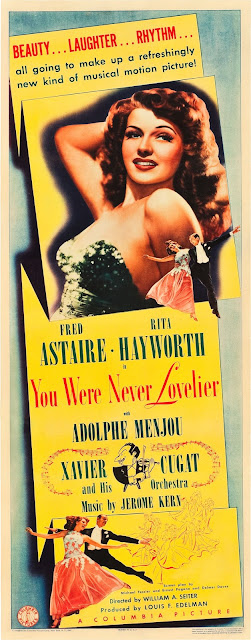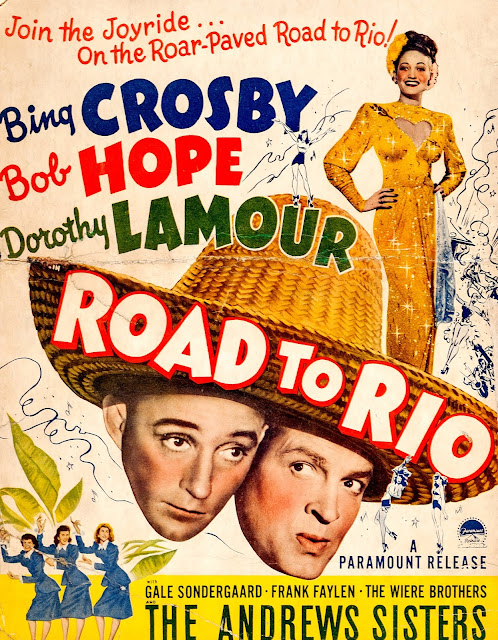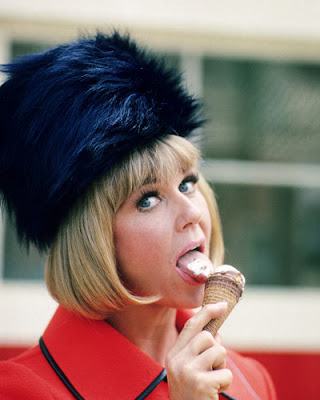Disney demonstrates its genius again in... 101 Dalmatians (1961)
I have zero patience. I wrote my first entry for this blogathon on Disney's magnificent Sleeping Beauty a day early, and while I planned on posting my second and final piece two days later, I just couldn't help myself. I get a weird rush out of publishing my posts, what can I say? Anyway, now I bring you a totally different Disney flick, the irresistible 101 Dalmatians. For the other great celebrations of cartoons, click here.
______________________
As a Disney Kid (copyright pending), you watch everything you can, from the minuscule to the major, and you don't just watch them once -- try at least a few dozen. When you're little, you don't really have a discerning taste yet. You know what's pretty and what's funny and what's sad, but you have no clue what exactly all the machinations are. For me, I didn't quite get 101 Dalmatians. I found it boring and stuck to that decision for the longest time. I was baffled every time I read a list or an article that praised the 1961 movie, so much so that my indifference started to bug me. When you can't remember exactly why you dislike a movie, maybe it's time to give it another chance. That's what I did last year, and the minute I pressed play on my DVD player, I saw the ghost of Walt Disney appear and say, "You were wrong, Michaela. You still have amazing taste, but here, you were wrong." I agree, Walt.
101 Dalmatians is brilliant in many ways. First of all, its style is intensely cool. The opening credits are a wonderful mixture of jazz and animation, an almost-surreal experience as we see landscapes painted before our eyes, dalmatian spots replacing music notes, and a shot of one dog zooming out to reveal hundreds, just to name a few moments. The illustrations are messier than usual, with colors going outside of the lines, giving you a devil-may-care feeling. There's a sense of calmness and relaxation that underlies the film, despite its conflicts.
For example: Cruella de Vil's introduction. Anita tells Roger that her old schoolmate Cruella will be stopping by, and dreading the woman's arrival, Roger composes the incredible "Cruella de Vil." His performance may be my favorite part of the movie, a funny and delicious moment that takes some of the villainy out of Cruella. When she does appear, she seems silly and non-threatening, as she stomps around and demands to know where the puppies are. Her motives aren't yet clear concerning the puppies, but her persistence about seeing them once they're born lets you know that she's up to something.
For example: Cruella de Vil's introduction. Anita tells Roger that her old schoolmate Cruella will be stopping by, and dreading the woman's arrival, Roger composes the incredible "Cruella de Vil." His performance may be my favorite part of the movie, a funny and delicious moment that takes some of the villainy out of Cruella. When she does appear, she seems silly and non-threatening, as she stomps around and demands to know where the puppies are. Her motives aren't yet clear concerning the puppies, but her persistence about seeing them once they're born lets you know that she's up to something.
I'm probably different than other 101 Dalmatians fans in the fact that I'm not particularly fond of, well, ninety-nine of the dalmatians. To me, the parts before the pups are born are the best. If we could have gotten a movie about Anita and Roger's courtship, I would be totally fine with it. They're a fabulous couple, a feature of the film I had forgotten about and was delighted to rediscover. Their scenes together are cuteness personified. One of the movie's more famous scenes is when Pongo orchestrates the meeting of Anita and Roger. Pongo thinks it's time his "pet" gets a mate, so when he spots Anita and her dalmatian Perdita out the window, he rushes Roger to follow them under the pretense of their daily 4 o'clock walk. Roger remains oblivious to it all, but Pongo catches the ladies eyeing them. He tries to get Roger to notice by taking his hat and setting it beside Anita, but horror of horrors, she and Perdita are leaving! Using his leash, Pongo drags his owner and winds up tripping the humans into the river. While it all spells disaster, everyone can't help but laugh once Roger offers Anita his handkerchief, not realizing it's no help since it's as wet as them.
Another thing that seemed to go over my head when I initially saw the movie was the seriousness of it. First of all, the biggie: Cruella kidnapping and planning to kill 99 puppies in order to make a coat. That's freaking messed up. When she tells Jasper and Horace to stop watching TV and get to killing the dogs, the guys protest that they don't know how. "Any way you like! Poison them, drown them! Bash them in the head! ... I don't care how you kill the little beasts, just do it!" I wince every time.
On the other side of that, however, is the
grief that falls over Roger, Anita, their live-in maid Nanny, Pongo, and Perdita. I'm majorly attached to my dog, so seeing Roger et al. crying over the disappearance of the puppies is devastating. Roger just knows that Cruella took them, but he can't prove it and finds himself helpless. However, Pongo and Perdita's mourning is even greater -- after all, they lost their children. When they set out to find their pups, it's sincerely heartwarming.
But none of that compares to one simple scene early in the film. On a stormy night, Anita and Nanny are downstairs helping Perdita deliver the puppies while Roger and Pongo are nervously waiting in the kitchen. Roger furiously puffs on his pipe, as if he were awaiting the birth of his own child. Finally, Nanny bursts in to excitedly announce how many puppies were born, the number climbing until it reaches fifteen. "15?! Well done, Pongo my boy!"
Pongo becomes delirious with happiness, until Nanny sadly enters and says, "Fourteen." She brings
Roger the blanket-clad puppy that didn't make it, Pongo suddenly heartbroken.
Roger has an idea, though -- he begins rubbing the puppy, everything going silent except for the ticking clock. Seconds go by, building your hope, until finally the pup peeks his little head out and touches noses with his father. There's no way this scene could fail to give you goosebumps.
When I picked Sleeping Beauty and Dalmatians, I had no idea how connected they were in Disney's history. Beauty was considered the end of the classic era -- Walt Disney loved the mid-century, classical designs of his previous films, which basically ended with Beauty, and he had a hard time embracing the contemporary feel of Dalmatians. The film was a turning point for the studio because of a few things. It was the first film set in the actual year it was released, and its source material wasn't a classic story or a fairy tale, but rather a 1956 book by Dodie Smith. The biggest change for the studio, though, was a copy machine. That's right: Xerox changed animation.
Since Disney began, pencil drawings were given to the ink and paint department, a primarily female group whose job was to put transparent cels over the drawings and color everything in, providing a lot of rich detail. Disney legend Ub Iwerks ushered in the Xerox copiers to save the company money. Spread in three rooms, a lens took a picture of the cleaned-up pencil drawing, which was then transferred to a plate that was dipped in toner. The toner would transfer the drawing to a clear cel, making for a faster process. Before completely investing in the copier, a test case was done on the dragon scene in Sleeping Beauty. Ironically, its success led to Sleeping Beauty becoming the last hand-inked, hand-painted film Disney did.
Story artist Floyd Norman, who worked at the studio during this time, said "I think we did lose something because the Xerox line lacked the subtlety of the ink line, which was incredible." He admitted that it can be debated whether Xerox was a step forward or back, and conceded that 101 Dalmatians "pushed the studio in a new direction." A lot of the animators liked the new process because the ink and paint department sort of changed the look of their drawings, but Xerox allowed for their original idea to go directly on the screen. For the first time, the animators felt like their true work was shown to the public.
While this is great, I think I have to agree with Mr. Norman's sentiment -- some magic gets lost in the Xerox process. Over the years, Xerox copying gave way to computers, which funnily enough was then used to replicate the ink and paint process. Nothing can challenge the lushness and purity of the hand-inked and -painted stuff, though. It's just too enthralling. That being said, I don't want to take away from the design of Dalmatians. It's charming and still fresh, even after fifty-four years. It deserves the modernization of the Xerox process for sure. I'm just saying I wish we could sometimes bring back the more personal touch.
One of the biggest pushes for me to revisit Dalmatians was Rod Taylor, a weird statement if you're not familiar with the fact that Taylor voiced Pongo. When I was little, there was no way I would've cared who was actually behind the characters, but now that I love classic films, going back to Disney films and seeing who the voice actors were is seriously mindblowing. I'll close this post with some fun facts on the actors of Dalmatians:
- Ben Wright voiced Roger, but Bill Lee was the singing voice. Lee was like the male Marni Nixon for Disney, but he also worked outside of the studio. For example, he did Christopher Plummer's singing for The Sound of Music.
- Wright also has a connection to The Sound of Music. He was a character actor, with bit parts in My Fair Lady, Judgment at Nuremberg, and The Fortune Cookie to name a couple, but he's probably best known for playing Herr Zeller, the Nazi official who catches the von Trapps leaving their house and keeps an eye on them during the music festival at the end. Wright's last job was actually for Disney -- he voiced Grimsby, Prince Eric's advisor, in The Little Mermaid (1989).
- J. Pat O'Malley (Jasper and the Colonel) amazingly did all the voices except Alice in the "Walrus and the Carpenter" segment in Alice in Wonderland (1951), including Tweedledum and Tweedledee.
Recognize him? It's Jock from Lady and the Tramp!
Also from Lady and the Tramp is Peg, the dog in the basket. Am I the only one who thinks she looks like Goldie Hawn in dog form?
And there's Lady herself in the forefront there!







































































Very enjoyable! I'm surprised to read that you could do without 99 of the dalmatians, but other than that, I think you've nailed the movie's charms pretty well!
ReplyDeleteThanks! If I'm being honest, I'm not what you would call a "children person," so it's a given that anytime kids pop up in a movie, I get slightly... less interested? (Sorry to any parents offended by this.)
DeleteI've always liked this film – I love the animation style, Cruella deVille's "look" and the sweet love story between Roger and Anita.
ReplyDeleteThanks for sharing all your research and providing a new (to me) context for this film. :)
I was oh so happy to do it! I find the stories behind Disney's animation fascinating and not too well-known, so I love to share what I find out. Thanks for reading!
DeleteYou forgot to mention tramp on the right hand corner of the screen in the shot where you say Lady makes an appearance 😉
ReplyDeleteOther than that, very nice entry. I know this was some time ago, but i still have an appreciation for these movies that will live on forever. And I can see you feel the same way!
ReplyDelete